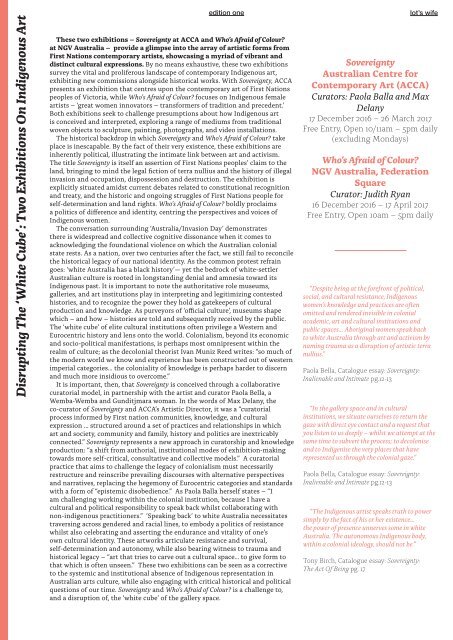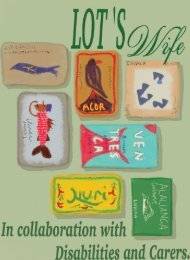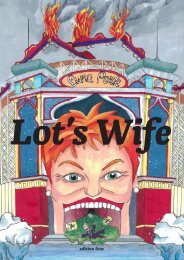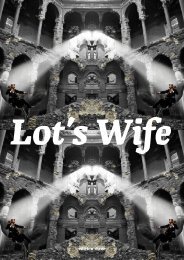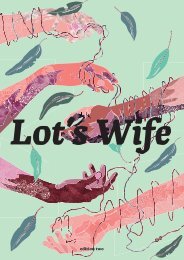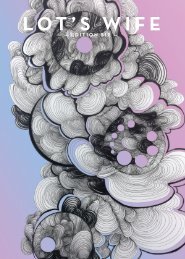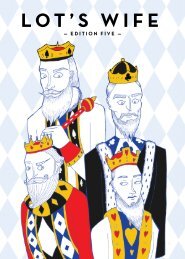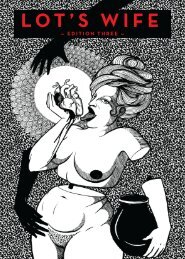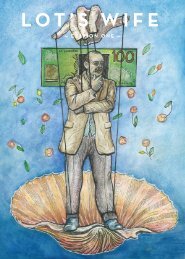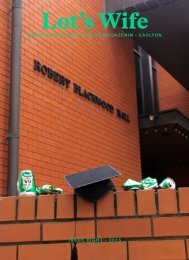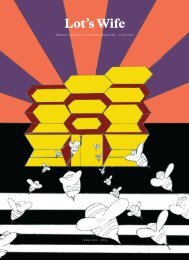Lot's Wife Edition 1 2017
You also want an ePaper? Increase the reach of your titles
YUMPU automatically turns print PDFs into web optimized ePapers that Google loves.
Disrupting The ‘White Cube’: Two Exhibitions On Indigenous Art<br />
edition one<br />
These two exhibitions – Sovereignty at ACCA and Who’s Afraid of Colour?<br />
at NGV Australia – provide a glimpse into the array of artistic forms from<br />
First Nations contemporary artists, showcasing a myriad of vibrant and<br />
distinct cultural expressions. By no means exhaustive, these two exhibitions<br />
survey the vital and proliferous landscape of contemporary Indigenous art,<br />
exhibiting new commissions alongside historical works. With Sovereignty, ACCA<br />
presents an exhibition that centres upon the contemporary art of First Nations<br />
peoples of Victoria, while Who’s Afraid of Colour? focuses on Indigenous female<br />
artists – ‘great women innovators – transformers of tradition and precedent.’<br />
Both exhibitions seek to challenge presumptions about how Indigenous art<br />
is conceived and interpreted, exploring a range of mediums from traditional<br />
woven objects to sculpture, painting, photographs, and video installations.<br />
The historical backdrop in which Sovereignty and Who’s Afraid of Colour? take<br />
place is inescapable. By the fact of their very existence, these exhibitions are<br />
inherently political, illustrating the intimate link between art and activism.<br />
The title Sovereignty is itself an assertion of First Nations peoples’ claim to the<br />
land, bringing to mind the legal fiction of terra nullius and the history of illegal<br />
invasion and occupation, dispossession and destruction. The exhibition is<br />
explicitly situated amidst current debates related to constitutional recognition<br />
and treaty, and the historic and ongoing struggles of First Nations people for<br />
self-determination and land rights. Who’s Afraid of Colour? boldly proclaims<br />
a politics of difference and identity, centring the perspectives and voices of<br />
Indigenous women.<br />
The conversation surrounding ‘Australia/Invasion Day’ demonstrates<br />
there is widespread and collective cognitive dissonance when it comes to<br />
acknowledging the foundational violence on which the Australian colonial<br />
state rests. As a nation, over two centuries after the fact, we still fail to reconcile<br />
the historical legacy of our national identity. As the common protest refrain<br />
goes: ‘white Australia has a black history’— yet the bedrock of white-settler<br />
Australian culture is rooted in longstanding denial and amnesia toward its<br />
Indigenous past. It is important to note the authoritative role museums,<br />
galleries, and art institutions play in interpreting and legitimizing contested<br />
histories, and to recognize the power they hold as gatekeepers of cultural<br />
production and knowledge. As purveyors of ‘official culture’, museums shape<br />
which – and how – histories are told and subsequently received by the public.<br />
The ‘white cube’ of elite cultural institutions often privilege a Western and<br />
Eurocentric history and lens onto the world. Colonialism, beyond its economic<br />
and socio-political manifestations, is perhaps most omnipresent within the<br />
realm of culture; as the decolonial theorist Ivan Muniz Reed writes: “so much of<br />
the modern world we know and experience has been constructed out of western<br />
imperial categories… the coloniality of knowledge is perhaps harder to discern<br />
and much more insidious to overcome.”<br />
It is important, then, that Sovereignty is conceived through a collaborative<br />
curatorial model, in partnership with the artist and curator Paola Bella, a<br />
Wemba-Wemba and Gunditjmara woman. In the words of Max Delany, the<br />
co-curator of Sovereignty and ACCA’s Artistic Director, it was a “curatorial<br />
process informed by First nation communities, knowledge, and cultural<br />
expression … structured around a set of practices and relationships in which<br />
art and society, community and family, history and politics are inextricably<br />
connected.” Sovereignty represents a new approach in curatorship and knowledge<br />
production: “a shift from authorial, institutional modes of exhibition-making<br />
towards more self-critical, consultative and collective models.” A curatorial<br />
practice that aims to challenge the legacy of colonialism must necessarily<br />
restructure and reinscribe prevailing discourses with alternative perspectives<br />
and narratives, replacing the hegemony of Eurocentric categories and standards<br />
with a form of “epistemic disobedience.” As Paola Balla herself states – “I<br />
am challenging working within the colonial institution, because I have a<br />
cultural and political responsibility to speak back whilst collaborating with<br />
non-indigenous practitioners.” ‘Speaking back’ to white Australia necessitates<br />
traversing across gendered and racial lines, to embody a politics of resistance<br />
whilst also celebrating and asserting the endurance and vitality of one’s<br />
own cultural identity. These artworks articulate resistance and survival,<br />
self-determination and autonomy, while also bearing witness to trauma and<br />
historical legacy – “art that tries to carve out a cultural space… to give form to<br />
that which is often unseen.” These two exhibitions can be seen as a corrective<br />
to the systemic and institutional absence of Indigenous representation in<br />
Australian arts culture, while also engaging with critical historical and political<br />
questions of our time. Sovereignty and Who’s Afraid of Colour? is a challenge to,<br />
and a disruption of, the ‘white cube’ of the gallery space.<br />
lot’s wife<br />
Sovereignty<br />
Australian Centre for<br />
Contemporary Art (ACCA)<br />
Curators: Paola Balla and Max<br />
Delany<br />
17 December 2016 – 26 March <strong>2017</strong><br />
Free Entry, Open 10/11am – 5pm daily<br />
(excluding Mondays)<br />
Who’s Afraid of Colour?<br />
NGV Australia, Federation<br />
Square<br />
Curator: Judith Ryan<br />
16 December 2016 – 17 April <strong>2017</strong><br />
Free Entry, Open 10am – 5pm daily<br />
“Despite being at the forefront of political,<br />
social, and cultural resistance, Indigenous<br />
women’s knowledge and practices are often<br />
omitted and rendered invisible in colonial<br />
academic, art and cultural institutions and<br />
public spaces… Aboriginal women speak back<br />
to white Australia through art and activism by<br />
naming trauma as a disruption of artistic terra<br />
nullius.”<br />
Paola Bella, Catalogue essay: Sovereignty:<br />
Inalienable and Intimate pg.12-13<br />
“In the gallery space and in cultural<br />
institutions, we situate ourselves to return the<br />
gaze with direct eye contact and a request that<br />
you listen to us deeply – whilst we attempt at the<br />
same time to subvert the process; to decolonise<br />
and to Indigenise the very places that have<br />
represented us through the colonial gaze.”<br />
Paola Bella, Catalogue essay: Sovereignty:<br />
Inalienable and Intimate pg.12-13<br />
“The Indigenous artist speaks truth to power<br />
simply by the fact of his or her existence…<br />
the power of presence unnerves some in white<br />
Australia. The autonomous Indigenous body,<br />
within a colonial ideology, should not be.”<br />
Tony Birch, Catalogue essay: Sovereignty:<br />
The Act Of Being pg. 17


